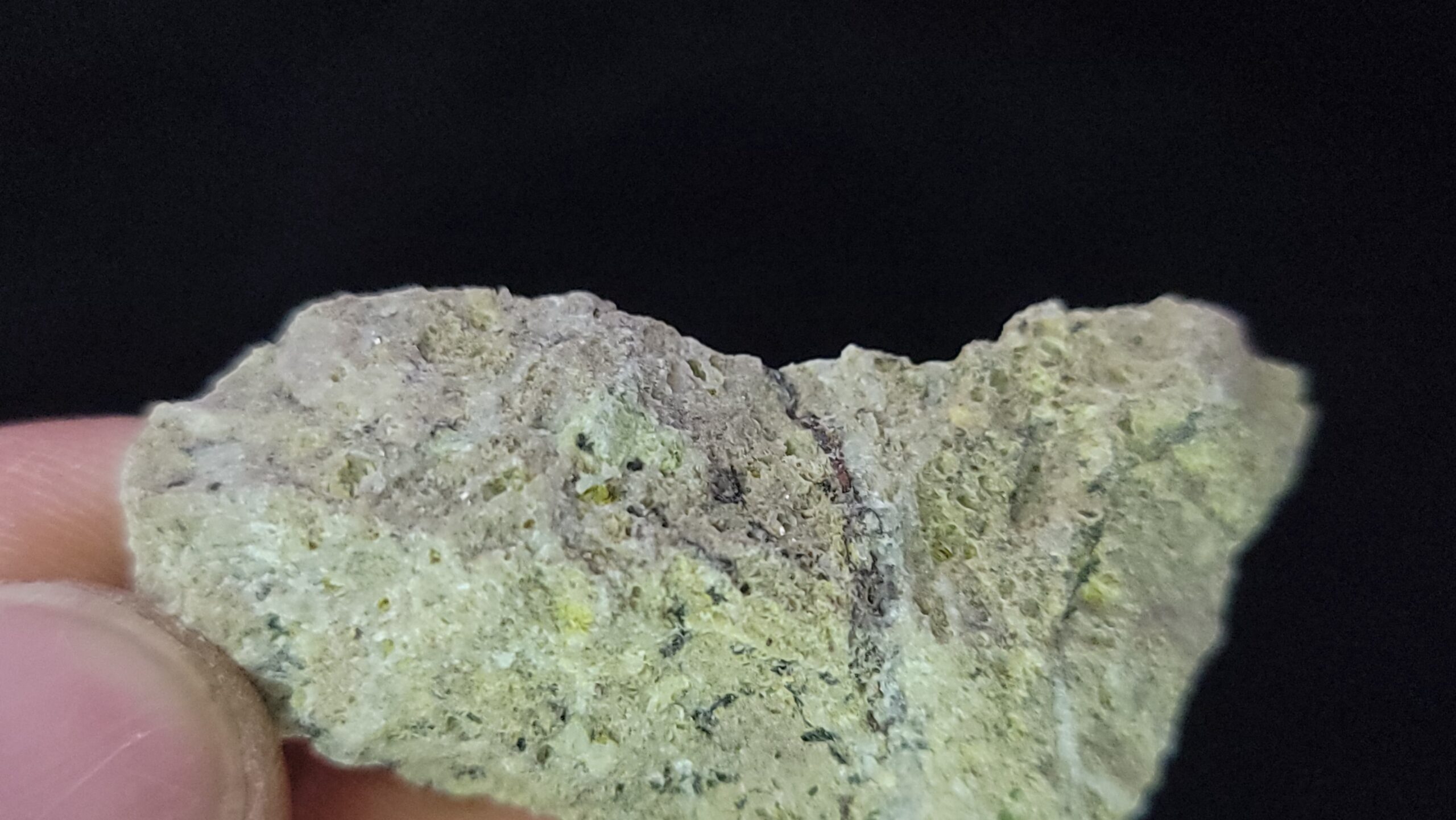Description
It’s pretty cool you can find some diamonds in Colorado, or in another Kimberlite pipe near to you, so keep an eye out for a rock like this!
Most of the following is taken from Wikipedia:
Kimberlite is an igneous rock and a rare variant of peridotite. It is most commonly known to be the main host matrix for diamonds. It is named after the town of Kimberley in South Africa, where the discovery of an 83.5-ct diamond called the Star of South Africa in 1869 spawned a diamond rush and the digging of the open-pit mine called the Big Hole.
Kimberlite occurs in the Earth’s crust in vertical structures known as kimberlite pipes, as well as igneous dykes. Kimberlite also occurs as horizontal sills. Kimberlite pipes are the most important source of mined diamonds today. The consensus on kimberlites is that they are formed deep within the mantle. Formation occurs at depths between 150 and 450 km (93 and 280 mi), potentially from anomalously enriched exotic mantle compositions, and they are erupted rapidly and violently, often with considerable carbon dioxide and other volatile components. It is this depth of melting and generation that makes kimberlites prone to hosting diamond xenocrysts.
About 6,400 kimberlite pipes have been discovered in the world, of those about 900 have been classified as diamondiferous, and of those just over 30 have been economic enough to diamond mine.
The Kelsey Lake Diamond Mine is now a defunct diamond mine in Colorado. It is located in the State Line Kimberlite District, near the Wyoming border, and consists of nine kimberlite volcanic pipes, of which two were open pit mined. At the time it was operating, it was the United States’ only modern diamond mine, and only the second commercial diamond mining operation in North America, the first being in the Crater of Diamonds State Park, Arkansas which was mined in the early 1900s.
Ever since diamonds had first been found in the State Line Kimberlite District in ’76, interest had been high in locating a viable commercial mining operation. Geologist Howard Coopersmith headed the Diamond Company L.N. which explored the feasibility of mining diamonds at the Kelsey Lake site. In’ 95 Australian firm Redaurum acquired controlling interest in Diamond Co. and proceeded to lease mining rights for the land around Kelsey Lake. Commercial output started in ’96. After mining and selling approximately 200 carats worth of diamonds, Redaurum was sued by Union Pacific who had originally sold the land in 1896 but claimed that it held on to the mineral rights. The two parties settled the lawsuit but in ’97 Redaurum decided to liquidate its diamond properties to concentrate on exploration.
The mine was operated sporadically until the operation was acquired by McKenzie Bay International Ltd. in ’00, then the mine ceased operations in ’01, and the site was fully reclaimed by ’06.
Of the nine volcanic pipes found, three were reported to contain diamonds, and two were mined. These two pipes are each approximately 10.5 acres in area, are at least 350 feet deep, and are situated 0.5 mi apart. Bulk sampling during exploration in ’90 and ’91 recovered grades of 3.4 to 4.5 cts per hundred tons for diamonds larger than 2 millimetres (0.079 in). Of the diamonds recovered, 50-65% were gem quality, and 25-30% of those were 1 ct or larger.
While Redaurum ran the operation, the mine ran at half-capacity and produced almost 12,000 carats in ’96 and 9,000 carats in ’97. When McKenzie Bay first acquired the mine, they estimated that each of the two pipes being mined had about 340,000 carats worth of gems and could be profitably mined for about 10 years. The previous owners had a marketing agreement with local Denver diamond dealers to sell them Kelsey Lake diamonds for $115 per carat. If production had risen to the expected levels of 60,000 carats per year, McKenzie Bay expected to make $6.9 million annually. However, with the rising prices of vanadium McKenzie Bay shifted their focus away from Kelsey Lake and began mine reclamation procedures in 2003.
In ’94, a 14.2-ct, gem-quality white diamond was recovered, at the time it was the sixth-largest diamond ever found in North America and was described as “almost flawless”, estimated to be worth $250,000. Then, in ’96, the largest diamond found at the mine was discovered. Named the “Colorado Diamond,” the 28.3-ct yellow stone was then the fifth-largest diamond found in North America. That gem was cut and polished by legendary New York diamond cutter Bill Goldberg which yielded a 5.39-ct faceted stone that sold for $87,500. Finally, in ’97, the company found two gem-quality stones weighing in at 16.3 cts and 28.2 cts. The 28.2 ct diamond was cut into a 16.86-ct stone, one of the largest finished stones ever produced in North America.























Reviews
There are no reviews yet.